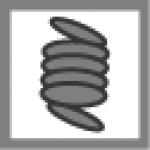Table 1.
Cancer Therapies Targeting Various Hallmarks of Cancer
| Agent | Target | Addiction | Hallmarks | Potential mechanisms | References |
|---|---|---|---|---|---|
| 17AAG (small molecule) | HSP90 | NOA |

|
A geldanamycin analog that binds to the ATP-binding pocket of HSP90 and inhibits its catalytic activity | Whitesell and Lindquist, 2005 |
| 1MT, MTH-Trp (small molecule) | IDO | NOA |

|
Inhibits tryptophan catabolism in tumor microenvironment to allow T cell proliferation | Muller and Scherle, 2006 |
| 5-fluorouracil (small molecule) | DNA | NOA |

|
Inhibits pyrimidine metabolism, incorporation in to DNA and RNA causes cell-cycle arrest | Longley et al., 2003 |
| ABT-737, ABT-263 (small molecule) | BCL-XL, BCL-2 | OA |

|
Bind to the BH3 pocket of Bcl-XL and inhibit its antiapoptotic function | Stauffer, 2007 |
| Alvocidib, PD 0332991 (small molecule) | CDKs | OA |

|
Inhibit CDKs and induce cell-cycle arrest | Lee and Sicinski, 2006 |
| AP 12009 (antisense oligo) | TGFβ 2 | NOA |
|
Inhibits tumor autocrine and paracrine signaling, reverses immune suppression in the tumor microenvironment | Muller and Scherle, 2006 |
| AZD2281, AG014699 (small molecule) | PARP1 | NOA |

|
Inhibit base excision repair in homologous recombination repair-deficient cancer cells | Bryant et al., 2005; Farmer et al., 2005 |
| Bevacizumab (antibody) | VEGF | NOA |

|
Inhibits endothelial cell recruitment and tumor vasculature | Folkman, 2007 |
| BEZ235 (small molecule) | PI3K | OA |

|
Causes cell-cycle arrest in tumor cells and inhibits tumor angiogenesis | Maira et al., 2008 |
| Bortezomib (small molecule) | Proteasome | NOA |

|
Inhibits the catalytic activity of 26S proteasome and induces apoptosis | Roccaro et al., 2006 |
| Celecoxib (small molecule) | COX2 | NOA |
|
Reverses immune suppression in the tumor microenvironment, inhibits tumor autocrine and paracrine signaling | Muller and Scherle, 2006 |
| Cisplatin and analogs (small molecule) | DNA | NOA |

|
Induces DNA crosslinks | Siddik, 2003 |
| Erlotinib, Gefitinib (small molecule) | EGFR | OA |

|
Inhibit EGFR tyrosine kinase by competing with ATP binding | Sharma et al., 2007 |
| GRN163L (modified oligo) | hTERT | OA |

|
Mimics telomere sequence and inhibits the hTERT active site | Dikmen et al., 2005; Harley, 2008 |
| GRNVAC1 (cell therapy) | hTERT | OA |

|
Autologous dendritic cells transduced to express an hTERT-LAMP fusion protein to elicit T cell response to hTERT + tumor cells | Harley, 2008; Su et al., 2005 |
| GV1001 (peptide) | hTERT | OA |

|
A short immunogenic peptide from hTERT designed to elicit T cell response against hTERT + tumor cells | Harley, 2008; Nava-Parada and Emens, 2007 |
| Imatinib, Dasatinib (small molecule) | BCR-ABL, c-Kit, Src, PDGFR, other TKs | OA |

|
Tyrosine kinase inhibitor with multiple targets | Quintas-Cardama et al., 2007 |
| Mapatumumab, Lexa-tumumab (antibody) | TRAIL receptor | NOA |

|
Bind and activate TRAIL receptors to induce apoptosis | Carlo-Stella et al., 2007 |
| Methotrexate (small molecule) | DHFR | NOA |

|
Inhibits thymidine biosynthesis and induces replicative stress | McGuire, 2003 |
| Nutlin-3 (small molecule) | HDM2 | OA |

|
Binds to HDM2 and inhibits the binding and ubiquitination of p53 | Vassilev, 2007 |
| Oblimersen (antisense oligo) | BCL-2 | OA |

|
Inhibits the expression of BCL-2 by blocking translation of its mRNA | Moreira et al., 2006 |
| Paclitaxel, Vinblastine (small molecule) | Mitotic spindle | NOA |

|
Interfere with dynamics and stability of mitotic spindles, activate mitotic checkpoints, and induce chromosome mis-segregation | Weaver and Cleveland, 2005 |
| PF-00477736 (small molecule) | Chk1 | NOA |

|
Prevents activation of the DNA damage response, leading to persistent DNA damage and replication stress | Ashwell and Zabludoff, 2008 |
| PRIMA-1, MIRA-1 (small molecule) | Mutant p53 | TSGH |

|
Reactivate the function of mutant p53 | Selivanova and Wiman, 2007 |
| Rapamycin, RAD001, Temsirolimus (small molecule) | mTOR | NOA |

|
Inhibit protein synthesis | Guertin and Sabatini, 2007 |
| Retinoic acid (small molecule) | RAR, RXR | OA |

|
Induces cellular differentiation | Spira and Carducci, 2003 |
| SAHBs (stapled peptide) | BCL-XL, BCL-2 | OA |

|
Stapled BH3 domains that bind to BCL-2 family members and promote apoptosis | Verdine and Walensky, 2007 |
| Sorafenib, Sunitinib (small molecule) | Multiple kinases (VEGFR, RAF, c-Kit, PDGFR) | NOA |

|
Inhibit endothelial cell recruitment and tumor vasculature | Folkman, 2007 |
| Topotecan, Irinotecan (small molecule) | Topo-isomerase I | NOA |

|
Induce DNA breaks | Pommier, 2006 |
| Trastuzumab (antibody) | ERBB2 | OA |
|
Inhibits ERBB2 activation and induces immune destruction of cancer cells | Hynes and Lane, 2005 |
Therapeutics are selected based on the diversity of their chemical structures, the hallmarks they attack, and their cellular targets. These agents are either investigational drugs or approved for selective oncology indications. Abbreviations: OA, oncogene addiction; NOA, non-oncogene addiction; TSGH, tumor suppressor gene hypersensitivity. Symbols for each hallmark refer to those used in Figure 1.
